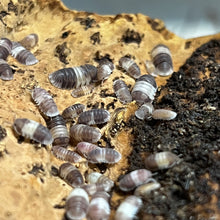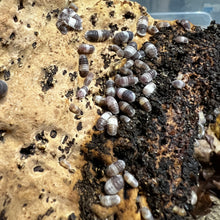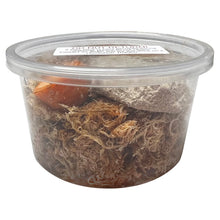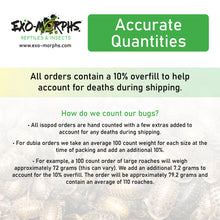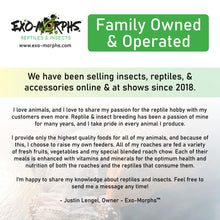
Panda King isopods are a fascinating group of terrestrial isopods that belong to the genus Cubaris, which includes several species known for their distinctive appearances and unique behaviors. The name "Panda King" comes from the unique black and white coloration on its body, which resembles the markings of a panda bear. Here's an overview of these fascinating creatures:
Scientific Classification
- Genus: Cubaris
- Family: Armadillidiidae
- Cubaris is a genus within the family of pill bugs, which includes species that can roll into a ball when threatened (similar to the more commonly known pill bugs or "roly-polies").
Appearance
Cubaris isopods are often visually distinct from other species due to their varied colors and patterns. They are relatively small compared to other isopods, and many species in this genus feature beautiful, vibrant colorations and markings. Here are some common traits of Cubaris isopods:
- Size: They can range from 1 to 2 centimeters in length, which is fairly small for an isopod.
- Shape: Like other pill bugs, Cubaris species have a rounded, segmented body that allows them to curl up into a ball when disturbed.
- Coloration: Cubaris isopods exhibit a variety of colors, including shades of brown, yellow, orange, and even metallic or iridescent hues. Some species have intricate patterns that make them especially striking.
-
Notable Species:
- Cubaris murina (also known as the "Papaya Isopod"): Known for its beautiful pinkish or peach-colored body.
- Cubaris sp. "Cappuccino": A species with a highly decorative appearance, often having a contrast of light and dark brown and white tones or a pattern resembling a frothy cappuccino.
- Cubaris sp. "Bumblebee": Known for its black and yellow striping resembling a bumblebee.
Habitat
- Native Range: Cubaris isopods are typically native to Southeast Asia, particularly in tropical and subtropical regions like Malaysia, Thailand, and other countries in the region. Panda Kings are typically found in the caves of Vietnam.
- Environmental Preferences: In the wild, they live in moist, humid environments such as leaf litter, decaying wood, and soil in forests. They thrive in these conditions due to their need for moisture to breathe through their gills.
Care and Maintenance (in Captivity)
Cubaris isopods are becoming increasingly popular in the exotic pet trade, and many hobbyists keep them in terrariums. If you are considering keeping Cubaris isopods, here are some care tips:
- Humidity: They require a high level of humidity, around 70–80%, and should be misted regularly. They can suffer from dehydration if the environment becomes too dry.
- Substrate: A mix of coconut coir, sphagnum moss, and leaf litter makes an excellent substrate that helps retain moisture. You can also add pieces of bark or decaying wood.
- Temperature: They prefer temperatures between 70°F and 80°F (21°C to 27°C), with stable warmth and humidity levels.
- Diet: Cubaris isopods are detritivores, which means they feed on decaying plant matter, fungi, and other organic debris. Offering them a diet of leaves, vegetable scraps, and commercial isopod food is ideal. It's important to provide a variety of food to ensure a balanced diet.
- Water: A shallow water dish can be provided for drinking, but be careful to avoid too much standing water, as it could drown them. Instead, regular misting is often enough to maintain humidity levels.
Behavior
- Rolling into a Ball: Like other pill bugs, Cubaris species can roll into a ball when they feel threatened. This behavior is a defense mechanism against predators.
- Social Structure: Cubaris isopods are social creatures and do well in groups. They tend to be active at night (nocturnal), hiding in the substrate during the day and emerging at night to forage for food.
- Slow Movements: These isopods tend to move slowly and are not particularly fast, making them interesting to watch as they scavenge around their enclosure.
Reproduction
- Breeding: Cubaris isopods reproduce through internal fertilization, and females carry their fertilized eggs in a brood pouch until the young hatch. The young are miniature versions of the adults and will mature over time.
- Offspring: Once hatched, the young isopods are independent and will begin foraging for food on their own, although they may remain close to the mother for some time.
Popularity
Cubaris isopods have become increasingly popular in the isopod hobby due to their unique coloration, large size, and captivating behaviors. They are often kept by collectors for their aesthetic appeal and ease of care. Many species of Cubaris are also sought after for their rarity, especially in regions outside of their native Southeast Asia.
Common Challenges
While they are relatively easy to care for, Cubaris isopods do have some specific environmental needs that must be met. If the humidity drops too low or if they do not have enough food, they may become stressed or unhealthy. Additionally, keeping multiple species together can sometimes cause issues, as some may compete for resources or territory.
Conclusion
Cubaris isopods are beautiful, easy-to-care-for creatures that make fantastic pets for anyone interested in keeping exotic invertebrates. Their unique ability to roll into a ball, vibrant colors, and fascinating behaviors make them a favorite among hobbyists. With the right environment and care, these isopods can thrive and provide hours of enjoyment for their keepers.







